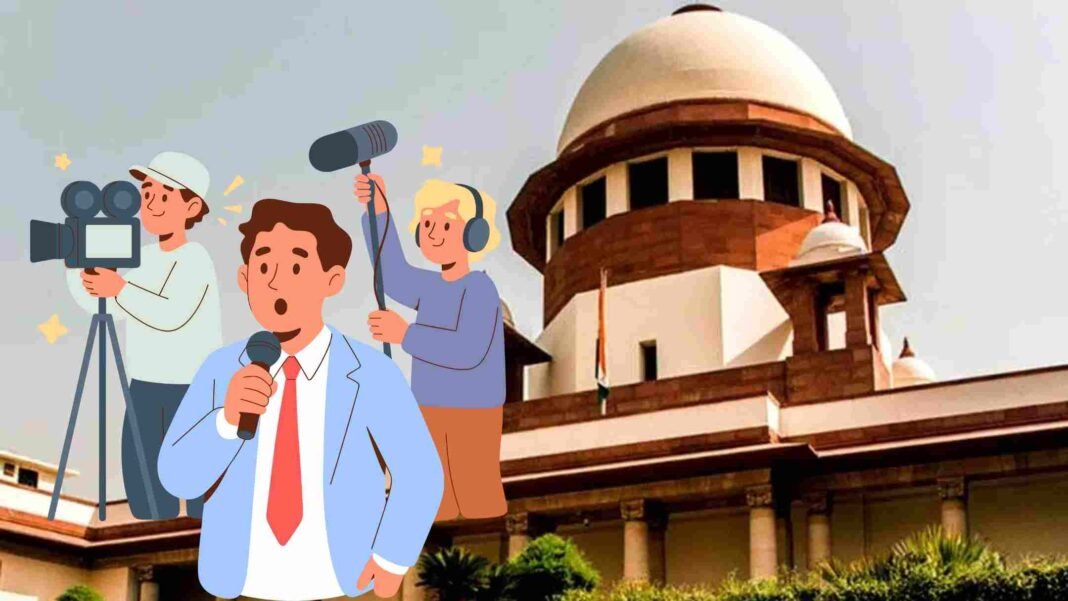The judicial system stands on three cardinal pillars — independence, fairness, and transparency. In recent years, however, the concept of “transparency” has taken on a new dimension with live reporting, live blogging, and live streaming of court proceedings. What began as a constitutional promise of open justice has evolved into real-time updates on Twitter/X, YouTube livestreams of hearings, and minute-by-minute legal commentary blogs.
While this has democratized access to courtrooms and increased civic engagement, it also raises the pressing question — is live reporting strengthening or hindering justice?
To answer this, we examine both sides — the benefits and the risks — including a closer look at the journalists, legal commentators, and live bloggers who now act as intermediaries between the courts and the public.
The Rise of Live Court Reporting
Traditionally, journalists could attend open court hearings, take notes, and report summaries after proceedings concluded. However, with the digital era and platforms and several independent legal commentators on social media, reporting has become instantaneous.
Today, high-profile cases — from the Ayodhya dispute and the Article 370 hearings to same-sex marriage petitions and electoral bond arguments — are often live-tweeted as they unfold. Reporters inside courtrooms or press galleries post real-time updates, providing the public with unprecedented access to judicial deliberation.
While this “live” coverage is a leap in transparency, it also creates a dynamic where the courtroom becomes a space of performance and public consumption — blurring the line between judicial communication and digital spectacle.
Advantages of Live Reporting and Live Blogging
- Public Awareness and Legal Literacy
Live blogs and tweets make complex legal arguments accessible to laypersons. Outlets like Bar & Bench and LiveLaw have become primary sources for millions who cannot access physical courtrooms but wish to follow constitutional cases in real time. This aligns with the constitutional ideal that justice must not only be done but be seen to be done.
- Transparency and Accountability
Real-time reporting discourages arbitrary behaviour or procedural opacity. It allows journalists and citizens to verify whether court processes are being followed fairly, ensuring judicial accountability through observation. In countries such as the UK and Canada, accredited court reporters act as “eyes and ears of the public” — a function that modern Indian legal blogs are now performing digitally.
- Archival and Research Value
Continuous live coverage creates a record that supplements official transcripts and orders. For law students, researchers, and journalists, these live threads provide valuable insights into advocacy techniques, judicial reasoning, and constitutional discourse.
- Civic Engagement and Confidence in Institutions
Live reporting bridges the gap between citizens and the judiciary, fostering trust and demystifying the process. When citizens follow major constitutional hearings as they unfold, they perceive the judiciary as accessible, not an elite or opaque institution.
The Role — and Responsibility — of Court Reporters
Court reporters and live bloggers have become indispensable to modern judicial journalism. However, their power also entails enormous responsibility.
1. Accuracy vs. Speed
The pressure to post updates instantly can lead to paraphrasing errors or misquotations of judges and lawyers. A single misplaced word may distort meaning, mislead the public, or even impact ongoing litigation.
2. Contextual Integrity
Court proceedings involve rapid exchanges between multiple actors — judges, lawyers, clerks, and witnesses. Stripped of tone, pauses, or legal context, snippets of dialogue can misrepresent intent.
Responsible court reporters must therefore interpret rather than merely transcribe — providing context and distinguishing between judicial observations and final orders.
3. Ethical Neutrality
Live reporting must avoid editorialising. Reporters are expected to convey proceedings objectively, not advocate for a side.
With the rise of opinionated legal influencers, the boundary between journalism and commentary is thinning — creating risks of bias or selective amplification.
4. Respect for Courtroom Decorum
Judges have occasionally cautioned against live tweeting that disrupts proceedings or creates distraction.
The Supreme Court’s own live streaming guidelines emphasise that reporting must not interfere with the court’s decorum or intimidate participants.
5. Legal Risks and Accountability
Misreporting judicial remarks may amount to contempt of court or defamation. Many high courts now require reporters to register with the Public Relations Office before covering sensitive cases.
In short, while live bloggers have enhanced access, their credibility depends on restraint, verification, and respect for judicial sanctity.
When Live Reporting Becomes a Hindrance to Justice
Despite noble intentions, live reporting can at times undermine justice in subtle ways:
- Trial by Public Opinion
Real-time updates can trigger public outrage or social-media campaigns that influence perception before the verdict. This phenomenon — “trial by Twitter” — risks eroding the presumption of innocence, especially in criminal matters or politically charged cases.
- Pressure on Judges and Lawyers
Awareness of being constantly reported can create self-censorship or performance anxiety. Judges may choose words cautiously or avoid candid questioning to prevent misinterpretation; lawyers may argue for effect rather than substance.
- Distortion Through Viral Fragments
Short clips, screenshots, or selective quotes often go viral, stripped of nuance. The resulting narratives may be far removed from the actual proceedings, yet shape public memory of the case.
- Privacy and Protection of Witnesses
Victims, minors, and witnesses may feel exposed or intimidated knowing their testimonies are being live-reported online. This can reduce candour and harm the truth-seeking function of the trial.
- Operational Challenges
Courts must manage accreditation, seating, and device permissions for reporters, which adds logistical complexity. Judges sometimes suspend live reporting mid-proceeding to prevent misinformation, highlighting the friction between openness and order.
International Experience
United Kingdom: Only accredited court reporters may tweet, and only in specific cases with judicial permission. Audio or video recording is prohibited except for judgments.
United States: Live blogging is permitted in some federal courts but restricted in criminal trials to protect juror impartiality.
Canada & Australia: Courts stream select hearings through official channels but discourage independent live commentary from the public gallery.
India: A hybrid model exists — the Supreme Court and several High Courts live-stream constitutional cases officially, while journalists in open courts continue to live blog under self-imposed ethical codes.
Balancing Transparency with Fair Trial
For live reporting to serve justice rather than hinder it, a calibrated approach is essential:
- Accreditation & Training – Only accredited legal correspondents or verified bloggers should be allowed to live report from inside courtrooms. Basic training in court reporting ethics should be mandatory.
- Time-Delayed Reporting – A short delay (e.g., 10–15 minutes) between the proceedings and publication can help fact-check and prevent misinformation.
- Editorial Oversight – Newsrooms and portals must implement verification workflows to cross-check quotes before posting.
- Case-Specific Restrictions – Courts should retain discretion to restrict live reporting in sensitive cases involving sexual offences, minors, or national security.
- Guidelines for Social Media Reporting – The Supreme Court or Press Council could issue a code of conduct for digital legal reporters, balancing Article 19(1)(a) freedom with Article 21 rights to fair trial and privacy.
- Public Awareness – Readers should be educated that live blogs represent ongoing arguments, not judicial decisions.
Conclusion
Live reporting from courtrooms — whether through official streams or journalists’ minute-by-minute blogs — marks a profound evolution in judicial transparency. It makes the courts more open, accountable, and accessible to the public.
Yet, without ethical discipline, contextual accuracy, and privacy safeguards, this transparency can morph into spectacle. The role of reporters is therefore not merely to inform, but to interpret responsibly, ensuring that public knowledge does not become public prejudice.
The key lies in balance: transparency without sensationalism, accountability without intimidation, and access without erosion of dignity. When that balance is maintained, live reporting becomes not a hindrance — but a handmaiden — of justice.
Read More: Tribunal Reforms Act, 2021: Supreme Court Hears Debate on Tribunal Tenures


